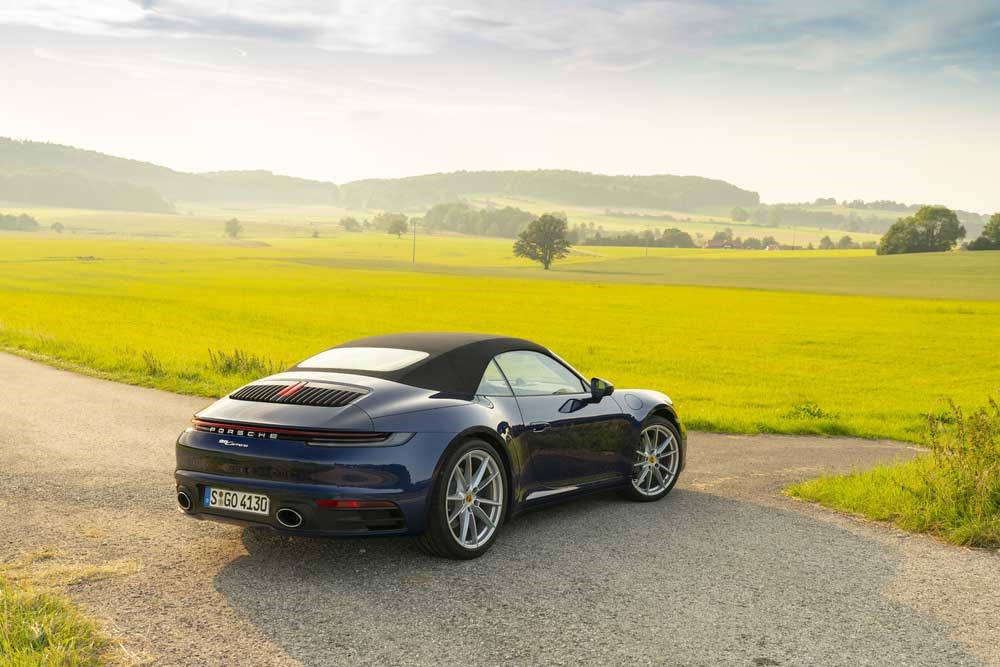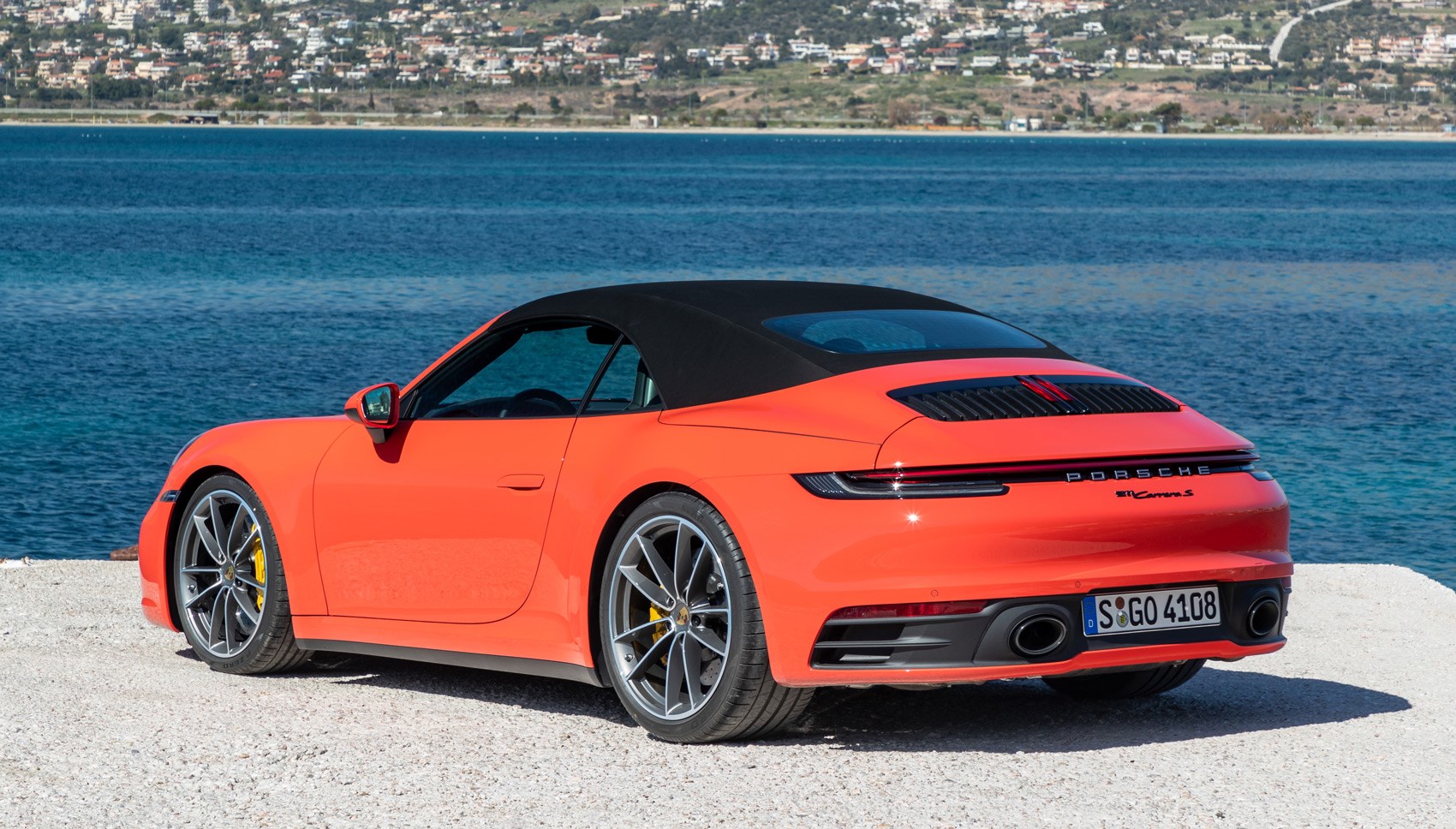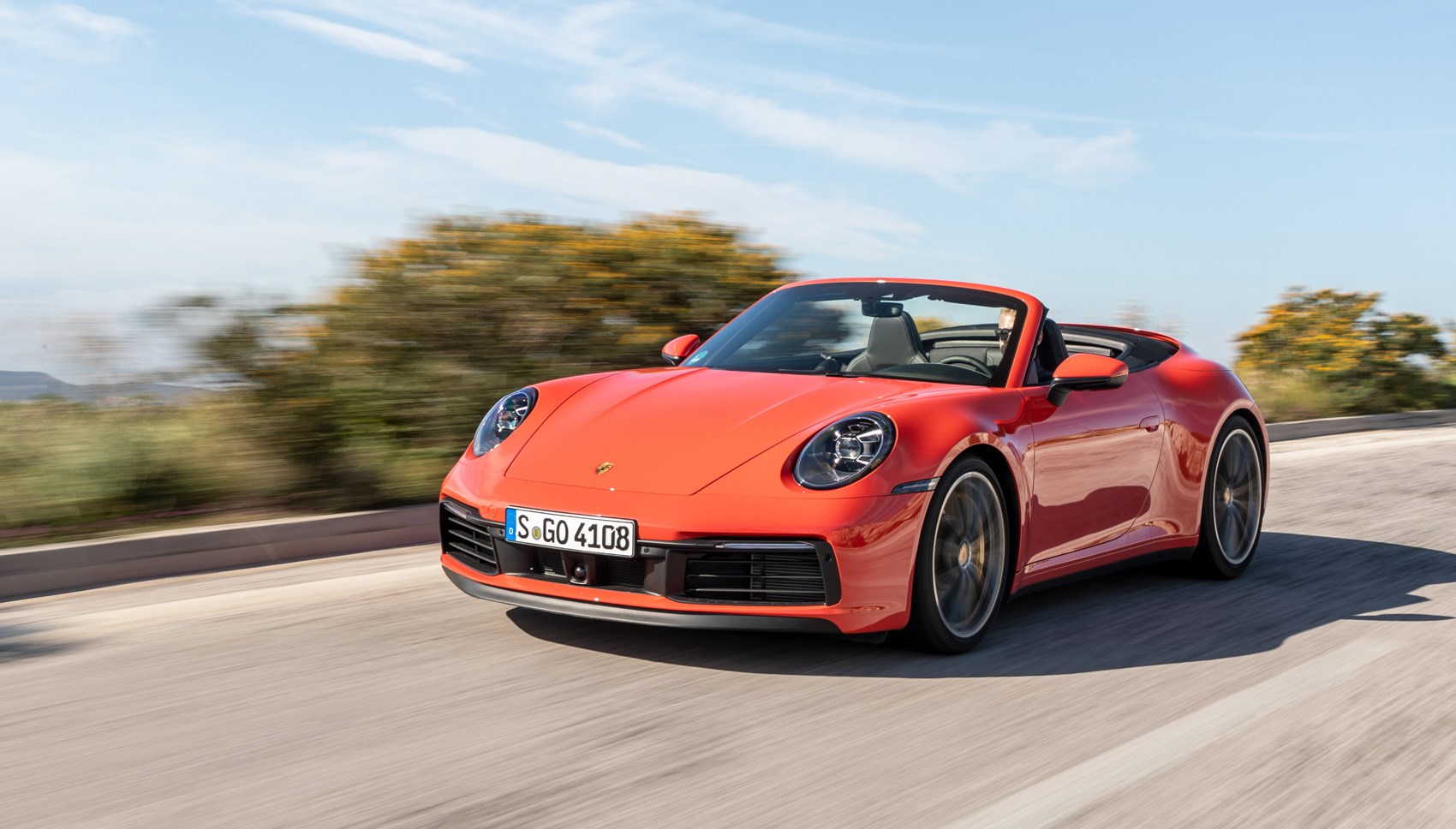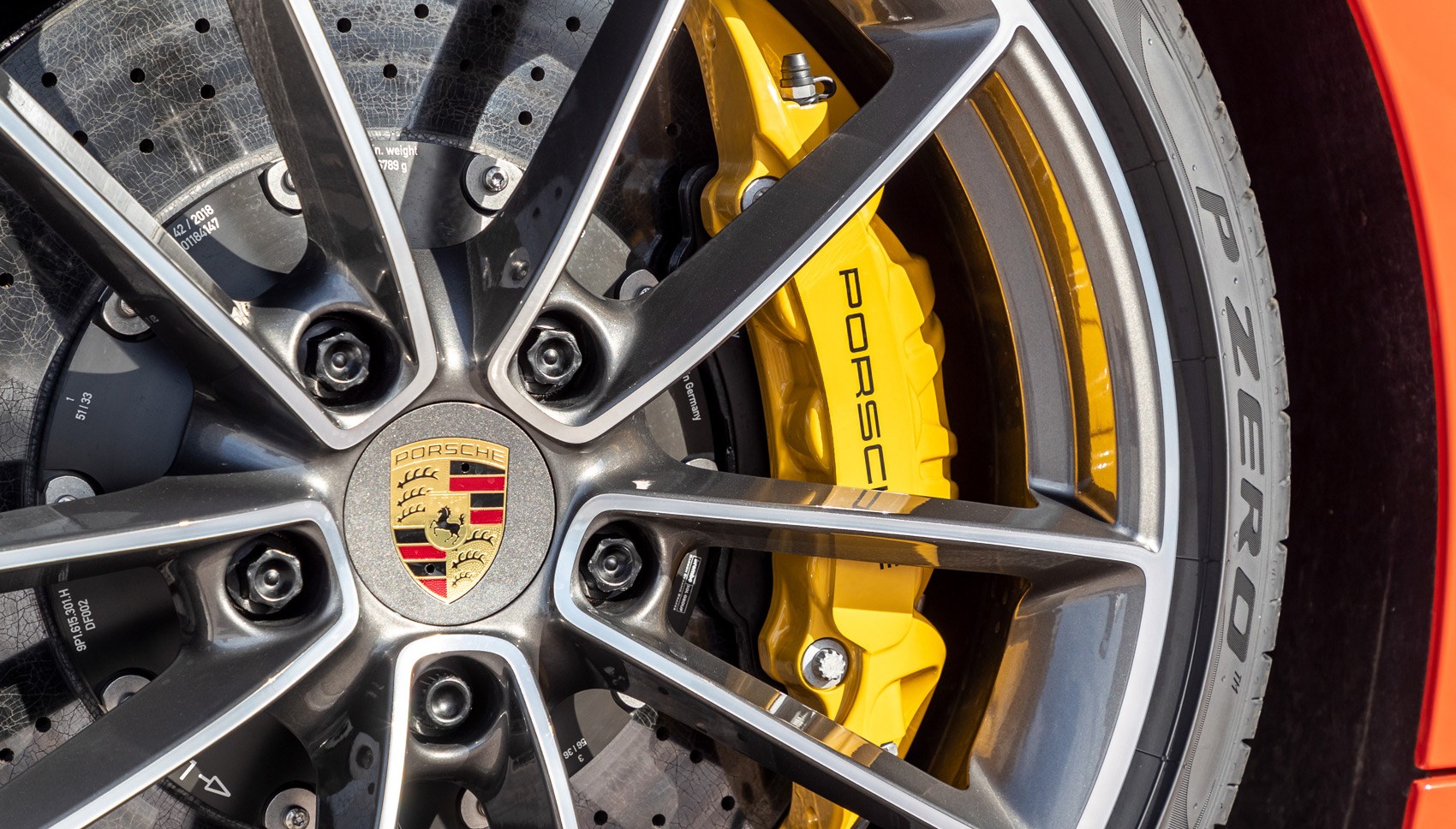► New Porsche 911 Cabriolet reviewed
► Driven in Carrera, S and 4S specs
► Priced from £92,438 for a C2
Convertibles, cabriolets, roadsters, speedsters – call them what you will but Porsche has a long tradition of removing roofs from cars: the first ever Porsche, a 356, was a roadster, one in three Porsches sold globally are open-topped, and a cabriolet has been a staple of the 911 line-up since 1982. Now there’s a new model, with the internal codename 992.
At launch, the Porsche 911 Cabriolet is available in Carrera, Carrera S and 4S variants, all with the PDK dual-clutch gearbox, for £92,438, £102,755 and £108,063 respectively. A seven-speed manual transmission is coming in spring 2020, engineers have confirmed to CAR magazine, althoug the PDK seems better suited to convertible life.
The cabriolet comes just a short while after the 992 coupe, so click that review to get up to speed with the main changes – we’ll keep it cabriolet-specific here. We’ve just driven the new Carrera 2 entry-level model, so we’ve fully updated this review with our musings on the entry-level 992 convertible (below).

Does the 992 Cabriolet use an all-new roof?
No, the Z-fold roof mechanism and the fabric itself is identical to the previous model, but the electro-hydraulic mechanism is improved, with a higher-performance hydraulic pump. The changes mean it’s quieter, and opens from closed (or vice versa) in 12 seconds, a two-second improvement. As before, it will open at up to 32mph – apparently there’s an extra 6mph or so in reserve, but opening a roof at 32mph feels pretty intense anyway, like your tent’s about to blow away in a storm.
There’s also an integrated wind deflector. It deploys from behind the rear seats – unless someone’s in them, or the front seats are too far back. No faffing about clipping something into place, and it works really well, instantly reducing buffeting and making conversation much easier when on the move.

In both Carrera and S models (above), improved noise insulation has been targeted for the 992, with an extra fleece layer sandwiched between the previous outer and inner layers. It’s said to reduce noise levels in the cabin by around 10% and we found the soft-top admirably hushed at most speeds in all versions we’ve driven. The final link in the chain is the A-pillars, just as strong as they were, but now with a new composite mix that drops 2.7kg.
What are the drawbacks versus the coupe?
They’re not huge, but the obvious one is price – it increases almost £9k over the equivalent coupe. And if you get busy with the options, watch out: we drove one entry-level Porsche 911 Cabriolet Carrera whose price had swollen to €159,000! In terms of functionality and aesthetics? Well, the roof mechanism is packaged very tightly – impressively so – under the tonneau cover and above the flat-six engine, but it is just slightly higher, perhaps 10mm or so say the experts. This is mostly due to the repositioning of the intercoolers.
Somehow, your eye is drawn more to that fact when the roof is down than it is when up – perhaps because the line of the roof is continuous and diverts your attention away. It does look a little bulkier at the rump.

Weight increases 70kg over a coupe, but weight distribution is said to be virtually unaffected, at least roof-up. Most CAR readers probably know that cabriolets are less stiff than coupes, but torsional stiffness drops by a pretty huge sounding ‘more than 50%’, from the coupe’s 40,000Nm per degree to 15,000 Nm – while both figures are improvements, the gap between coupe and cabrio is comparable to the previous 911. For reference, the Jaguar F-type R coupe posted a figure of 33,000Nm in 2014, up 80% on the convertible.
Don’t be alarmed by this, though: the soft-top 911 hardly feels like a jelly or blancmange when on the go, and engineering intergrity is every bit as solid as any other 911 we’ve tested.
How does the new Porsche 911 Cabriolet drive?
Very well. We’ve now driven three versions of the latest 992 soft-top and all have impressed. It’ll largely come down to your budget, your need for speed and your typical driving circumstances. The entry-level Carrera 2 is astonishingly fast, taking little over four seconds to hit 62mph from rest – so you’ll have to really need more performance to trade up. The problem is, the C2 (and 992 in general) is just so damn refined, quieter than before, almost too GT-like for its own good. Thankfully, Porsche is the master of filling every niche, so over time we feel confident that more 911 versions will arrive, many with fizzier dynamics and character to keep purists happy.
Our Carrera S Cabriolet test car was fitted with both optional rear-wheel steering and PASM sports suspension, which lowers the car 10mm on adaptive dampers, and has never been offered on a cabrio before – faster-acting dampers are the key in making the stiffer set-up work here. At low speeds in town it certainly feels focussed – not crashy, but definitely on the very firm side. If you’re driving is likely to be urban/lower speed/more relaxed, you’d probably be better served by regular adaptive suspension, though none of the test cars were equipped with it.

Equally, though, pottering about at low speed over fractured urban tarmac gives an indication of just how together the 911 cabrio feels, despite losing its roof – no tremors, shakes or slop here, it just feels solid, no matter what the objective drop in stiffness suggests.
What about when you up the pace?
It’s cracking, so good that’s easy to forget you’re not in a coupe. The ride that was a little fidgety in town frees up with speed, to meld impressive compliance with exceptional control. The steering has a chunky, pacey and precise feel that keeps it integrity even when you really lean on the chassis through tight turns, and the balance maintains a 911’s delicacy.
There’s a wider track, bigger tyres, and the extent to which you can now lean on the front end going in to corners and get on the power early out of them is pretty outrageous, but you can still play with understeer and oversteer and the lovely bit of rotation that happens when you back off just after the former and before you go hooligan-spec with the latter. It feels nimble and adjustable, but also composed and secure. Neat trick. We got the standard brakes smelling a bit on a hairpin-littered run, but the pedal kept its pressure and bite. The car stopped well.

Back in and out of the throttle on a twisty road and the turbo character of the 444bhp 3.0-litre flat six really bubbles to the surface too, with purposeful – if far from OTT – exhalations and whooshes that the open-top model only emphasizes (and are rarely present in normal driving). It has a gruffer turbo edge than the old 3.8 naturally aspirated motors, sure, a fraction of lag too, but this is a great engine, with good response, a muscular mid-range that the 3.8 couldn’t match, and a bandwidth that still encourages you to reach for the high notes. No longer can you say you’d be better off with a Boxster – there’s a big gulf now between this and the 718 Boxster’s four-cylinder turbo.
Paired with the excellent PDK gearbox, the 911 effortlessly quick yet never feels unrewarding.
Did you get in a 4S?
Yes. It’s highly enjoyable to drive, but its steering isn’t quite as fluid (the front wheels are driven, remember, which tugs at it somewhat), there’s a slightly bulkier feel generally, and the extra traction, while impressive, again isn’t quite as fluid as a 2S on a mission. For snowier climes, go for it, but the rest of us need no more than a 2S.
Does the fabric roof do the business?
It does. The roof looks taut and crisp both inside and out of the car, and even the extra shutlines required for the tonneau cover that lifts up to swallow the roof don’t really spoil the lines.
The mechanism motors back very quietly and as fast as Porsche promises, and you feel in the eye of the storm inside the cabin – surrounded by the elements, yes, but never battered by them. We did encounter one moment in our recent test of the new 911 Carrera Cabriolet where the rear right-hand side window refused to raise when we closed the hood on multiple occasions; this was mildly disconcerting when we so highly value Porsche quality, but it was put right by the age-old ‘turn-it-off-and-on-again’ routine and never returned.
Roof up, there’s generous headroom for taller drivers in the new Porsche 911 Cabriolet, but there’s still more bluster than you’d experience in a coupe, despite the fabric roof’s extra insulation. It’s not bad by any means, and it’s worth noting that we drove in very windy conditions, but it’s noise levels in the cabin that reinforce that you’re in a cabriolet where the dynamics don’t feel at all compromised.

You also lose a little rear visibility over a coupe – while it’s not a deal-breaker, it is noticeable. A reversing camera is standard too.
Porsche 911 Cabriolet (992): verdict
The extra cost, increased cabin noise and reduced rear visibility of the cabriolet would steer this particular writer towards a coupe, but if your heart is set on an open-top 911 there’s no other reason not to take the plunge. It drives exceptionally well, and feels composed even when worked hard over a highly demanding road. The cheaper, entry-level Carrera 2 is a worthwhile addition too – and still epically fast.
The appeal of the soft-top 911 is that you can drop the roof, enjoy the sun and revel in the flat-six soundtrack. It even does all the practical stuff a 911 always does, with plus-two rear seats and, of course, unaltered boot space. In fact, the cabriolet is arguably the more versatile 911. It’s come a long way since 1982.
Check out our other Porsche reviews